Mona Hodgson's Blog, page 27
December 27, 2012
20 Reasons to Attend a Writers’ Conference
I attended my very first writers’ conference in 1988, and have attended at least two every year since.
Counted among the best decisions I’ve ever made, attending writers’ conferences has proven to be an invaluable investment in myself.
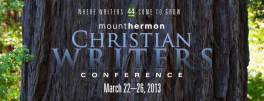
Do you dream of being a published writer? If so, here are twenty reasons why yoou should atened a writers’ conference.
1. Because you want to write for publication.
2. To learn what to write for publication.
3. To learn how to write for publication.
4. To learn who you should write for.
5. To find a kindred spirit in other writers.
6. To receive instruction in the craft of writing and the business of marketing.
7. To meet editors who are willing to invest time and effort into meeting new writers.
8. To meet agents who are interested in meeting potential clients.
9. To have your writing critiqued by a professional writer.
10. To have your writing evaluated by an agent or editor.
11. To discover the format(s) that best fit your style of writing.
12. To develop industry savvy.
13. To learn about the enormous amount of work, time, energy, and sacrifice involved in writing for publication.
14. To evaluate if writing for publication is something you indeed wish to pursue.
15. To build relationships with industry professionals.
16. To develop better self-editing skills.
17. To be inspired.
18. To meet potential critique partners.
19. To explore and study various genres and subgenres (fiction, mystery, writing for children, picture books, nonfiction, memoir, devotional, poetry, etc.).
20. To discover possible markets for your writing.
Do you have a question about writers’ conferences?
© 2012 Mona Hodgson, Author and Speaker


December 25, 2012
Mollie Kathleen Gortner: A Cripple Creek Woman
The fascinating women of the 1800s were not dissimilar to you and I, even though their circumstances varied greatly and required extra doses of pluck. They loved and lost. They laughed and cried. They tried and failed. Many tried again and were victorious. Relationships and community mattered to them. Faith played an important role in their strength and resiliency.
Mollie Kathleen Gortner was one of those women in Cripple Creek, Colorado.

Mollie Kathleen Gortner
In the spring of 1891, Mollie Kathleen’s son Perry left their home in Colorado Springs as a surveyor to map mining claims in Cripple Creek. All he talked about was the gold there. Wanting to see for herself what the fuss was all about, Mollie Kathleen loaded the family wagon with supplies and joined other wagons headed to Cripple Creek. She set up housekeeping in the log and canvas tent Perry had recently completed.
One day that September, Perry returned home from surveying with stories about seeing a huge herd of elk. Again, Mollie Kathleen decided to go out and see for herself. But she never made it up high enough to see the elk. When Mollie Kathleen stopped to rest, she looked downward and noticed an interesting rock formation winking at her. Pure gold laced in quartz. Having seen several prospectors in the area, Mollie Kathleen forced herself to remain calm and hid the ore sample in her clothing.
Consequently, Mrs. Mollie Kathleen Gortner became the first woman in the Cripple Creek District to discover gold and strike a claim in her own name.
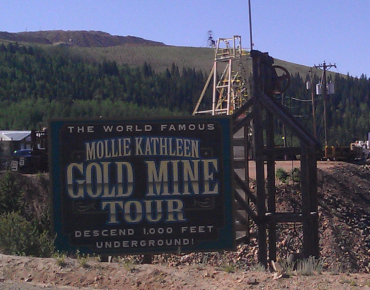
Although Mollie Kathleen staked the claim and owned the mine, it was her son Perry who kept an office out at the Mollie Kathleen Mine. As soon as Mollie Kathleen would set foot on the mine site, the miners would scramble up out of the tunnels. Turns out they were a superstitious lot who refused to be caught in a one-thousand-foot vertical shaft with a woman on the grounds.
In each of the four Sinclair Sisters of Cripple Creek novels, readers meet at least one real-life woman from Cripple Creek history. I introduced Mary Claver Coleman, the Reverend Mother of the Sisters of Mercy, in Two Brides Too Many. In Too Rich for a Bride, business entrepreneur Mollie O’Bryan helped add layers to Ida Sinclair’s journey. Doctor Susan Anderson, known as Doc Susie, came alongside our cast of fictional characters in The Bride Wore Blue. Mollie Kathleen Gortner is the primary real-life woman in Twice a Bride. Like the women in the previous stories, Mollie Kathleen’s portrayal in the story is a fictionalization.
I begin with fact—what I can learn about the woman from research. Then starting with what I know about “her story,” I figure out where her experience might intersect with my main characters in their story.
As a secondary character in Twice a Bride, Mollie Kathleen Gortner plays a pivotal role in Trenton Van Der Veer’s adjustment as a businessman in the Cripple Creek Mining District. Mollie Kathleen also serves as an inspiration to newcomer Willow Raines Peterson, a widow in search of a fresh start.

Mollie Kathleen Mine, Cripple Creek, Colorado
Fun Fact: The Mollie Kathleen Mine on the outskirt of Cripple Creek, Colorado is open to the public and offers underground tours into the 1,000 foot vertical mine shaft. See what life was like for the Old West hard rock miner. A fun and educational summer stop for families. For more information on the mine and the tour season, go to: http://www.goldminetours.com/goldminetours.com/Home.html.
Have you visited a mine? Gone into an underground mine? Which one?
© 2012 Mona Hodgson, Author and Speaker
All four Sinclair Sisters of Cripple Creek novels are also available for your eReader?


December 24, 2012
A Christmas Blessing and Celebration Songs!
![nativity_scene[1]](https://i.gr-assets.com/images/S/compressed.photo.goodreads.com/hostedimages/1381389903i/4794970.jpg)
Photo Credit: Somerset House Publishing, No Room in the Inn by Tom duBois
“‘Do not be afraid. I bring you good news that will cause great joy for all the people. Today in the town of David a Savior has been born to you; He is the Messiah, the Lord. This will be a sign to you: You will find a baby wrapped in cloths and lying in a manger.’ Suddenly a great company of the heavenly host appeared with the angel, praising God and saying, ‘Glory to God in the highest heaven, and on earth peace to those on whom His favor rests.’” Luke 2:10-14In Too Rich for a Bride, the Sinclair Sisters, Miss Hattie, and friends celebrated Christmas with music, gathered around a piano. I remember those days with my own family, my fingers walzing across the piano keys. It seemed right that my Christmas greeting to you would include both song and blessing.
Simply click on each of the three songs below to listen to them.
What Child is This by Carrie Underwood
Go Tell It On The Mountain by Charlie Peacock
May you, this day and in the coming year, experience the abiding love of Jesus, who came at Christmas, a humble servant, a redeeming Savior, and an invincible God.
Merry Christmas! A Blessed Christmas to you and yours!
Does your family use music in their celebration of Christmas? Is the music live? Is there a favorite song you sing or listen to?
© 2012 Mona Hodgson, Author and Speaker


December 23, 2012
Christmas Light: A Quilted Heart Devotional
In Dandelions on the Wind, Maren Jensen has immigrated to America, her heart full of plans to send for her family and give them a better life. When her failing eyesight narrows her own prospects for a new life, darkness begins to swallow her hope, along with her vision.

As Maren lifts a glowing match to the wick of an Advent candle to commemorate the coming of the Light of the world, she surrenders her darkness to God, looking to Jesus to be her Light.
“Then spake Jesus again unto them, saying, ‘I am the light of the world:
he that followeth me shall not walk in darkness, but shall have the light of life.’”
John 8:12, KJV
In what ways has Jesus been Light in your life this past year?
© 2012 Mona Hodgson, Author and Speaker
December 20, 2012
Gifting eBooks
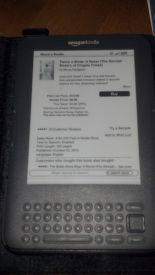
You want to give family and friends the gift of reading, but they prefer eBooks over traditional. No problem. You can gift eBooks.
Here are the steps to take:
1. Determine which eReader the recipient uses–Kindle, iPad, Nook, Sony, Kobo. Each eReader device or app has a companion e-bookstore.
2. To purchase the book, visit the website appropriate to the eReader’s bookstore.
Here are gifting links to various eReaders:
Gifting to Amazon eBooks for Kindle devices
http://www.amazon.com/b?ie=UTF8&node=2518188011
Search for books by Mona Hodgson
Gifting for an iPad, iPhone, or iPod Touch
http://www.cnet.com/ipod/
You can buy your friend a Nook or Kindle book and suggest he or she reads the book with a free iOS app.
Gifting to the Nook
http://www.barnesandnoble.com/u/nook-instant-gifts-ebooks-apps/379003333/
Search for books by Mona Gansberg Hodgson
Gifting to a Sony Reader
http://ebookstore.sony.com/gift-center/
Search for books by Mona Hodgson
Kobo eBook giftcards:
http://www.kobobooks.com/egiftcards
Search for books by Mona Hodgson
All four of my Sinclair Sisters of Cripple Creek novels are available for eReaders.
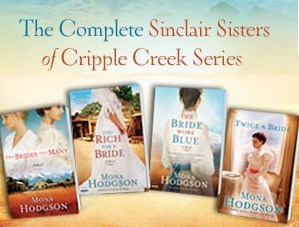
Two Brides Too Many, Too Rich for a Bride, The Bride Wore Blue, and Twice a Bride
The Quilted Heart Novellas are available for pre-order for eReaders.
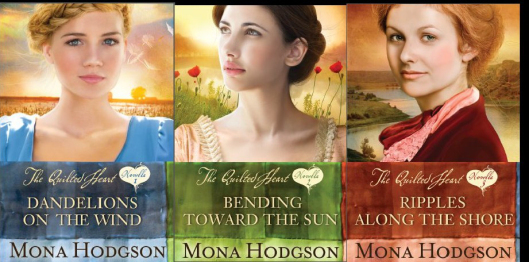
Dandelions on the Wind, Bending Toward the Sun, and Ripples Along the Shore
Are you giving an eReader or an eBook as a Christmas gift this year?
© 2012 Mona Hodgson, Author and Speaker
July 26, 2012
Out Take: Chapter One, The Bride Wore Blue
I chose instead to begin Vivian Sinclair’s story at a point of action, with her moving forward. But I kept the Out Take, and I thought you might enjoy a peek into Vivian’s past.
May 1897
Paris was her only option.
Vivian Sinclair lay across the windowpane crazy quilt on her bed. She needed to hear from Father again. Soon. Supported by her elbows, she revisited the handful of postcards he’d sent her from France, dreaming of the imminent day she would see those places for herself.
Once upon a time she was convinced that being the last child—the youngest—made her extra special. Thanks to Father and her three older sisters that’s how she’d felt as a little girl. And the only vivid memory she had of her mother supported her assumption. She’d crawl into bed beside Mama and listen to mother sing between the coughs that took her life.
My wee little one, youngest of my angels, God saved the sweetest angel for last.
Vivian had believed it. Until Gregory’s lies. Now that she’d grown up, she knew the truth: Being the youngest was a curse not a blessing. She could never live up to the standards her sisters’ had set. She’d made mistakes they would never make. No, she couldn’t go to Cripple Creek. She could face them. Neither could she remain in Portland.
She ran her index finger across the image of the sandy banks along the Seine River. She bent her finger at the water’s edge as if she could slide into the river finger-first and be washed clean.
A knock sounded on the door, and Vivian jumped up from the bed. “Just a—” Before she could stack her cards and finish her sentence, the flung door opened and her aunt stepped through the opening.
A strawberry-red braid crowned her aunt’s head like a halo. Aunt Alma glanced from Vivian to the rumpled quilt and back, her eyes narrowing. “You can’t mope around here forever. I say it was a rare act of chivalry that he let you off the hook when he did. Never trusted that weak chin of his. A sure sign he’s not the kind deserving of a prize like you.”
“I’m fine.” Vivian fanned the postcards and held them up. “I was only reclining and looking at Father’s writings to me.”
A slow smile deepened the laugh lines that framed her aunt’s green eyes. “Well then, I’d say I have superb timing.” She pulled a long envelope from the pocket on her duster and waved it like a banner. “I’ve just come from the post office.”
“A letter from Father?” Vivian’s heart hammered as she snatched the envelope and ran her finger along the seam.
“Dinner is nearly ready. You can read the letter to me while we eat.”
Vivian nodded. When she heard her aunt’s footfalls on the stairs, she closed the door and hurried to her bed. Vivian would miss her aunt and her sisters. She’d been anxious to meet her three brothers-in-law and her new niece, but Paris held her future. Living with Father would allow her a fresh start, a chance to pursue her dream of being a famous dress designer.
Perched on the foot of the bed, Vivian opened the envelope and slid out a piece of stationery much smaller than promised by its large packaging. She drew in a deep, hope-full breath, unfolded the sheet of paper, and began reading.
My dearest baby daughter,
Vivian sighed. Would her family ever regard her as anything but the baby?
I miss you and your sisters terribly. I would love nothing more than to gather all of my daughters around me for a Sunday supper and look on as the four of you engage in a Sinclair sisters’ checkers tournament.
Vivian felt her shoulders sag. She longed for that too. How she wished her life could return to those days before Kat and Nell left Maine as mail-order brides, bound for Cripple Creek. If only she could return to the days before Father’s job here changed and he had to go to Paris.
But, my dear daughter, I cannot bring you to Paris. I don’t live in the pictures in your head. My life here isn’t that which inspires the photographs in the postcards.
Her lips began to quiver. He was telling her no. She blinked hard against the tears blurring her eyes and forced herself to continue reading.
I live in an industrial district of smoke-belching factories populated by teamsters and longshoremen. Far from the romantic genteel Paris of your artistic sensitivities.
Vivian glanced at the window ledge where her cat slept then forced herself to finish reading.
It pains me to tell you no. Your mother would say I never was good at it. But, Vivian, you must join your sisters in Colorado. That’s where you belong. I am wiring the fare to your Aunt Alma, and she will see you safely to Cripple Creek.
All my love, Father
Vivian let the stationery flutter to the floor. If what her mother had taught her was true, God knew what she’d done and that where she belonged was far below Cripple Creek, Colorado.
http://monahodgson.wordpress.com/
April 25, 2012
Dr. Quinn Time
No, our two-day getaway to the cabin swallowed Saturday. Seriously? Saturday night was DR. QUINN, MEDICINE WOMAN night, and the modest cabin didn’t allow for TV viewing.
Don’t get me wrong--we’re all about retreating from noise and hectic pace of small town life and breathing in the pine-scented tranquility the mountains have to offer, but miss viewing Dr. Quinn (Jane Seymour) and Sully (Joe Lando) in “real time?” Far too much to ask. No way.
Sure too bad about our annual drive up the mountain to view and photograph deer and elk. We had to find a place with good television reception. The nearest town was a mere twenty or thirty miles away. Never mind that we’d be driving back to the cabin in the dark . . . in the land of bears and deer and elk. Where, oh where, could we go to catch up with the unstoppable Dr. Michaela “Mike” Quinn and mountain man Bryon Sully? Remember, this was before televisions lines the walls of most eateries. So, we brainstormed our options. Department stores that sold televisions? Sports bars? Uh, not the kind of shows they broadcast.
Ah ha! Hospital rooms have televisions. Yep. Off we went to the hospital, put our dollar bills into the vending machine, and searched for an empty room with a TV. With no time to spare, we settled into the outpatient waiting room and historic Colorado Springs with the beloved cast of DR. QUINN, MEDICINE WOMAN.
Yes, it was a dreary day when that show was cancelled. But fast forward to 2012. I’m a historical novelist, writing Old West fiction for WaterBrook Press and I’m still fascinated with the role of female physicians in the 1800’s. It’s no wonder then that Colorado doctor, Susan Anderson known as Doc Susie, serves as my “real life” character in The Bride Wore Blue, Book Three in The Sinclair Sisters of Cripple Creek Series.
Headed toward a fresh start but tethered by her past, Vivian longs to break free, to find forgiveness and love.
At last, the sisters are reunited! The youngest Sinclair, the family “baby,” is moving from Maine to Cripple Creek, Colorado and joining Kat, Nell, and Ida. But Vivian is a young woman with a will of her own, and made some decisions back in Portland that have begun to haunt her. Will she be able to live up to the expectations of her three perfect and now happily-settled sisters?
The sisters warmly welcome Vivian to the mountain west, but the wild-and-woolly mining town isn’t ripe with opportunities for a respectable young woman. The youngest Sinclair sister is determined to make her own way, so when she’s offered a job as a hostess in a sporting house, she takes it, thinking the position is appropriate for a tainted, unlovable woman like herself. Although she’s convinced she’ll never be asked to entertain privately, Vivian keeps her employment a secret from her sisters, knowing they’d be mortified—as will Carter Alwyn, the kind and godly sheriff’s deputy who’s sweet on her.
Vivian is descending into a life of secrets, lying to the very people who love her and could help her heal from her mistakes. Will an outpouring of grace remind her that she is still God’s beloved and that her past can be washed as clean as Rocky Mountain snow?
So is it Vivian or Sheriff’s deputy Carter Alwyn who has need of the good Doc Susie’s services? And who is at fault?
I’m not telling . . . not just yet, anyway. The official release date for The Bride Wore Blue is Tuesday, May 8th, but you can pre-order your copy now.
February 15, 2012
10 Reasons to Read and Write Historical Fiction
1. Introduction to significant events and influences from an era before my time. Whether it’s personal research or as a benefit to another author’s careful digging, historical fiction brings yesteryear to life. In Gone with the Wind by Margaret Mitchell, compelling characters introduced me to life on a plantation and to the widespread affects of the Civil War.
2. Information is an inherent feature of historical fiction and immerses the reader in a specific time and place in history. In Maid to Match, Deeanne Gist showed me what life might have been like in George Vanderbilt’s Biltmore Estate. I learned about scullery maids, footmen, and the role of a lady’s maid. In Ticket to Tomorrow, author Carol Cox put me in the Machinery Hall at the 1893 Chicago World’s Fair.
3. Illumination of faith and life beyond the natural boundaries of my imagination. Life in a North Carolina mansion, a Seattle logging camp, a medieval castle, the lowlands of Scotland, etc. Historical fiction sheds light and offers an explanation for a variety of historical mores. Yes, we’re talking about fiction, but in the best historical fiction most of the story components are rooted in truth.
4. Intersection with characters with whom I share a connection. Jo from Louisa May Alcott’s book Little Women was one of four sisters, as am I. She was also a writer. I connected with Jo at both of those crossroads.
5. Identification with characters who share my basic values and struggles. Sometimes the rapport and empathy may come in having experienced a similar situation, such as moving into new territory like Marty did in Jeanette Oke’s book, Love Comes Softly. Even though I haven’t experienced widowhood as Marty did, or married for the sake of convenience, I have felt lost in a new situation.
6. Interpretation is an imperative in the best historical fiction. A solid story set in history offers readers an analysis of the past and can help bring understanding in the wake of war, a natural disaster, or a personal or societal tragedy. Through the actions and reactions of characters like Scarlet O’Hara and Rhett Butler, we gain better understanding of human nature, ourselves, and interpersonal relationships.
7. Importance grows out of the heart of a historical novel. Harriett Beecher Stowe poured her heart and soul into her ground-breaking novel, Uncle Tom’s Cabin. Historical fiction can mark personal and societal milestones. A story may shed light on an issue such as slavery. It may chronicle the emergence of women in business as in my novel, Too Rich for a Bride. Or it may feature the exhilaration and scandal stirred by the foolhardy new activity of cycling as seen in Deep in the Heart of Trouble by Deeanne Gist.
8. Inspiration is a given when I become immersed in the lives of the stalwart women of the past, whether actual or fictional. In each of my books in The Sinclair Sisters of Cripple Creek Series, I include a real life woman from the time period and Cripple Creek history. In Two Brides Too Many, Sister Mary Claver Coleman serves as the real life woman. The reverend mother of the Catholic Order of the Sisters of Mercy who came to America from Ireland to establish schools and hospitals in needy areas. Inspiring! Driven by her personal loss and her hunger for retribution, DiAnn Mill’s fictional character in A Woman Called Sage is a bounty hunter. An inspiring tale of courage and second chances.
9. Imagination is stirred as I place myself beside characters on a plantation, in a mining camp, on a prairie schooner, in a boardinghouse, or at Kitty Hawk, watching the first airplane shudder in its lift off. Details stir the reader’s imagination. Whether it’s the hilarity involved in a British Lady’s decision to become a ranch hand out west as in Cathy Marie Hake’s novel Fancy Pants or the characteristics of a logging camp in search of brides as seen in A Bride in the Bargain by Deeanne Gist, the particulars an author chooses to include engage the mind’s eye of the reader.
10. Independence that grows out of a need to be a self-starter. In The Inheritance, Tamera Alexander uses family responsibilities and connections to spur her main character to draw on her independent spirit in a fresh start. Her parents gone, big sister McKenna Ashford loads up the family wagon and heads West with a rebellious brother at her side. Cholera epidemics, fires, war, widowhood, drought, a gold rush, and more served as the impetus for new beginnings.
I count it a privilege to work as a historical novelist, to be able to weave truth from historical events and settings with characters who are true to human nature. I’m taking what I’ve learned from my favorite historical novelists and pouring it into my debut series, The Sinclair Sisters of Cripple Creek.
Which historical novels do you count among your favorites, and why?
Ida Sinclair: The Star of Too Rich for a Bride
In preparation to write Ida Sinclair’s story, I interviewed her. I thought you might enjoy a glimpse at who Ida was before she left Portland, Maine to join her sisters Kat and Nell in Cripple Creek.
MONA: Who are you?
IDA: I am the big sister, the oldest daughter, the responsible one. I’m the one who makes things happen for other people. Isn’t this what the first-born does?
MONA: What do you want?
IDA: I want to make things happen for myself. I want to be a successful businesswoman, respected for my abilities and my hard work.
MONA: You expect to do that in a mining town out West?
IDA: Do you think it’s wrong for me to want success in the world of business, to earn my own money?
MONA: No, but it’s certainly not going to be easy. I only wanted to clarify your intentions for your fans.
IDA: My fans?
MONA: Yes, the Sinclair sisters—each of you--have a following of readers who care about you and your journey.
MONA: What has your life been like since your mother died?
IDA: The moon was high when I heard my father crying. I rushed into the hallway outside my parents’ bed chamber. Dr. Haufbauer stood there rocking back and forth, shaking his head and puffing his pipe. Ever since then, I’ve felt responsible for my father’s well-being and my sisters’ care. Now it’s time for me to follow my dream.
MONA: Have you left any room for romance in your plans? Do you believe in love?
IDA: Although I would like to eventually find love and wed, I’m not searching for a man. Right now romance would be a distraction I can’t afford. If I ever do decide to pursue love and marriage, it’ll be after I’ve found success in business.
MONA: What about your father’s wishes that you and your sisters find a man in Cripple Creek, Colorado who can provide for you?
IDA: Father isn’t in Cripple Creek. He’s busy working in Paris. Besides, I’m not one of the daughters he was worried about. He knows I can take care of myself. Soon, I’ll prove it to him.
MONA: What has your life been like since your father moved to Paris?
IDA: Focused and lonely. I take my business courses in the mornings and work in the school’s office in the afternoons. Aunt Alma’s house is comfortable, but cluttered. Vivian has a beau, but you don’t want to get me started on him. Anyway, between Vivian’s schooling and her fascination with Gregory, she’s too busy for much more than a Sunday checkers game with her big sister.
MONA: What one word would you use to describe the following people?
IDA:
Kat – wordsmith
Nell – homemaker
Vivian – Vivacious
Father – Steady
Aunt Alma - Entertaining
MONA: What word would you use to describe yourself?
IDA: Resourceful.
MONA: What word would your sisters use to describe you?
IDA: Dependable.
MONA: What word would your father use to describe you?
IDA: Capable.
MONA: How would you describe your relationship with God?
IDA: It’s more a battle for control, than a relationship.
MONA: Ida, now that you’ve been in Cripple Creek for a while, has your perspective changed any?
IDA: One, you should know, you wrote the book. Two, my story says it all, and I don’t want to spoil the read for the Sinclair sister fans.
Ida Sinclair has joined her sisters, Kat and Nell, in the untamed mining town of Cripple Creek, Colorado for one reason: to work for the infamous but undeniably successful businesswoman, Mollie O’Bryan. Ida’s sisters may be interested in making a match for their determined older sister, but Ida only wants to build her career.
Under Mollie's tutelage, Ida learns how to play the stock market and revels in her promising accomplishments. Fighting for respect in a man's world, her ambition leaves little room for distractions. She ignores her family's reservations about Mollie O'Bryan's business practices. No matter how she tries, she can't ignore the two men pursuing her affections—Colin Wagner, the dashing lawyer, and Tucker Raines, the traveling preacher.
As you read in her interview, Ida wants a career more than anything else, so she shrugs off the suitors and pointed "suggestions" that young ladies don’t belong in business. Will it take unexpected love—or unexpected danger—for Ida to realize where her priorities truly lie?
Happy Reading!
February 10, 2011
Wanted: A Mail-Order Bride Story
I had great fun living the life of a mail-order bride. Vicariously, that is, through the harrowing, humorous, and heart-warming experiences of Kat Sinclair and her sister Nell. Two sisters, two missing misters, and a shocking welcome to the Wild West.
What pulls you and I toward such an outrageous scenario as a woman leaving what she knows to step into the unknown with a man she doesn’t know?
Mail-order brides represent a stalwart breed of women who exude courage, strength, and a sense of adventure. They are women seeking a new beginning, opportunities, and financial security. We gravitate toward these stories because we like meeting a gutsy woman, young or older, who has a need to be married, but doesn’t have any promising prospects in her current circumstances. Their moxie might inspire us, but we’d happily do without the desperation that drives many of them west.
Usually, the heroine is connected to a possible mate through a response to some sort of advertisement. Wanted: A single woman who is willing to walk away from the life she knows to travel across the country or even around the world and marry a stranger. She must be willing to bear his children and take care of their home, all while causing him to grow in his affection for her.
The mail-order bride plot line is typically one in which a man living in a western country, most commonly out west in the United States, marries a woman from a depressed or oppressed country or from the male-deprived eastern United States, sight unseen. Personal advertisements for matrimony served as the link between mail-order brides and the men who sent for them.
The fellow placing the ad or responding to an ad may end up being the one the heroine marries, but what if he isn’t? What if he isn’t who he is purported to be? Or maybe it’s the heroine who wears a façade. If so, why? And where does the misleading and misgivings take the characters?
Sarah, Plain and Tall by Patricia MacLachlan is one of the most popular examples using the mail-order bride scenarios in fiction. Papa lost his wife and placed an ad in the newspaper. Easterner Sarah Elizabeth Wheaton responded, setting her adventure in the west with the widower and his two children in motion. The classic tale began as a children’s novel and emerged as a popular Hallmark television movie.
While the mail-order bride storyline is most commonly seen in historical fiction, the 1993 movie, “Sleepless in Seattle,” offered a contemporary twist on the classic story form. A motherless boy desperate to help his father find a new wife called into a radio show and told his father’s story of loss and loneliness. Letters flooded his father’s mailbox opening the door to a compelling and heart-warming romance.
In my debut historical novel, Two Brides Too Many, two of four Sinclair sisters travel west and arrive at the depot in Cripple Creek, Colorado expecting to meet the men with whom they’d corresponded. But when the ladies disembark at the train depot, neither fiance’ awaits them. The well-bred Sinclair sisters find themselves alone in the wild, frontier town—a place where fire threatens to reduce the buildings to rubble, the working women strut the streets, rogues will gamble for the shoes on one’s feet, and grace is found among the most unlikely of folks.
If you share my delight in mail-order bride stories with a twist, I hope you’ll ask your favorite bookseller for a copy of Two Brides Too Many.







